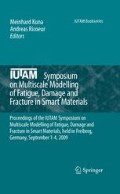Abstract
An optimization-based computational model is proposed for domain reorientation in polycrystalline ferroelastics. In this model, a polycrystalline ferroelastics is made up of numerous, random oriented grains, with each grain consisting of N types of domains. Under any prescribed loading condition, the fraction of each domain in a specific grain is obtained via an optimization process to minimize the free energy of the total grain. The mechanical constraint from neighboring grains is considered in an Eshelby inclusion manner. This model has the similar superiority as the phase field model that does not impose any priori domain-switching criterion. Meanwhile, the computational complexity of this model is fairly small and affordable in 3-D cases using numerous grains. Furthermore, this model can reproduce very well the Taylor’s rule of plasticity. Simulation results on tetragonal, rhombohedral and morphotropic PZT ceramics show the superiority and efficiency of this model. The domain texture evolution can also be calculated.
Access this chapter
Tax calculation will be finalised at checkout
Purchases are for personal use only
References
Otsuka K, Ren X (2005) Physical metallurgy of Ti-Ni-based shape memory alloys. Progress Mater Sci 50(5):511–678
Huber JE, Fleck NA, Landis CM et al (1999) J Mech Phys Solids 47:1663–1697
Li FX, Fang DN (2004) Simulations of domain switching in ferroelectrics by a three-dimensional finite element model. Mech Mater 36:959–973
Chen LQ (2002) Phase field models for microstructure evolution. Annu Rev Mater Res 32: 113–140
Schrade D, Mueller R, Xu B et al (2007) Domain evolution in ferroelectric materials: a continuum phase field model and finite element implementation. Comp Meth Appl Mech Eng 196(41–44):4365–4374
Bhattacharya K, Kohn RV (1996) Symmetry, texture and the recoverable strain of shape-memory polycrystals. Acta Mater 44:529–542
Li FX, Rajapakse RKND (2007) A constrained domain switching model for polycrystalline ferroelectric ceramics. Acta Mater 55, Part I-Model formulation and application to tetragonal materials, 6472–6480; Part II-Combined switching and application to rhombohedral materials, 6481–6488
Box MJ (1965) A new method of constrained optimization and a comparison with other methods. Comput J 8:42–52
Taylor GI (1938) Plastic strain in metals. J Inst Metals 62:307–324
Eshelby JD (1957) The determination of the elastic field of an ellipsoidal inclusion and related problems. Proc R Soc Lond A 241:376–396
Li JY, Rogan RC, Üstündag E et al (2005) Domain switching in polycrystalline ferroelectric ceramics. Nat Mater 4:776–781
Hoffmann MJ, Hammer M, Endriss A et al (2001) Correlation between microstructure, strain behavior, and acoustic emission of soft PZT ceramics. Acta Mater 49:1301–1310
Berlincourt D, Krueger HHA (1959) Domain processes in lead titanate zirconate and barium titanate ceramics. J Appl Phys 30:1804–1810
Bunge HJ (1982) Texture analysis in materials science. Butterworth, Berlin
Li FX, Rajapakse RKND (2007) Analytically saturated domain orientation textures and electromechanical properties of ferroelectric ceramics due to electric/mechanical loading. J Appl Phys 101:054110
Acknowledgments
This work is supported by the National Natural Science Foundation (Grant No.10872002) and the 985 Project Foundation of Peking University.
Author information
Authors and Affiliations
Corresponding author
Editor information
Editors and Affiliations
Rights and permissions
Copyright information
© 2011 Springer Science+Business Media B.V.
About this paper
Cite this paper
Li, F. (2011). An Optimization-Based Computational Model for Polycrystalline Ferroelastics. In: Kuna, M., Ricoeur, A. (eds) IUTAM Symposium on Multiscale Modelling of Fatigue, Damage and Fracture in Smart Materials. IUTAM Bookseries, vol 24. Springer, Dordrecht. https://doi.org/10.1007/978-90-481-9887-0_8
Download citation
DOI: https://doi.org/10.1007/978-90-481-9887-0_8
Published:
Publisher Name: Springer, Dordrecht
Print ISBN: 978-90-481-9886-3
Online ISBN: 978-90-481-9887-0
eBook Packages: EngineeringEngineering (R0)

